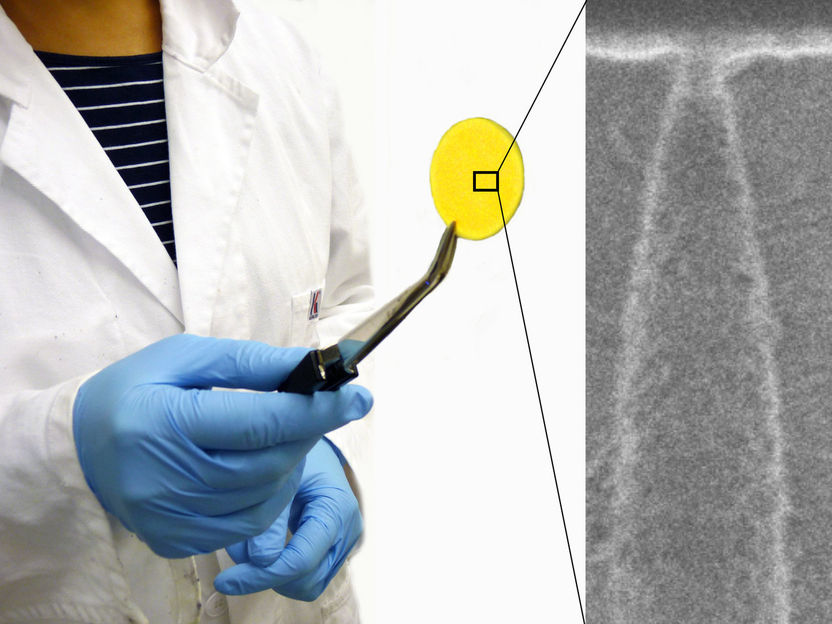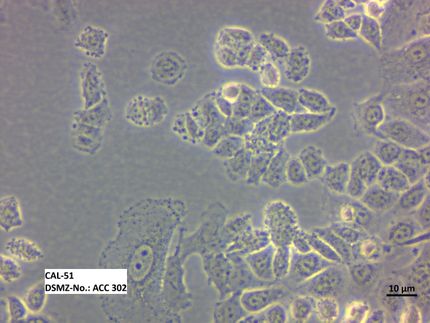New sensor for SARS-CoV-2 and other viruses
Better and faster virus detection with single-nanopore membranes
Easy and fast detection of viruses are crucial in a pandemic. Based on single-nanopore membranes of GSI, an international interdisciplinary team of researchers developed a test method that detects SARS-CoV-2 in saliva, without sample pretreatment, with the same sensitivity as a qPCR test, and in only 2 hours. On top, the sensor can distinguish infectious from non-infectious corona viruses — a crucial innovation.

Ion track nanotechnology from GSI Materials Research creates a highly sensitive nanopore.
GSI/FAIR
By linking different technologies, an interdisciplinary team of scientist of the Materials Research Department of GSI Helmholtzzentrum für Schwerionenforschung, the National Scientific and Technical Research Council (CONICET) in Argentina and the University of Illinois in the USA, has developed a highly sensitive nanopore sensor that specifically detects SARS-CoV-2 viruses and human adenoviruses in a variety of specimen including saliva, serum or environmental samples such as wastewater. The sensor combines two key components: a sensitive nanochannel and highly specific DNA molecules attached to the channel surface. According to the research groups, the method is as precise as PCR tests, but simpler and faster providing results in less than two hours. The results are published in the journal Science Advances.
The technology for the fabrication of membranes with single nanopores has been developed at GSI over many years. Thin polymer films are irradiated with one individual high-energy heavy ion projectile (e.g. 1 GeV gold ion) at the linear accelerator UNILAC. As the ion passes through the film, it creates a nanoscopic damage trail that is converted into an open nanochannel by chemical etching. The precise diameter and the shape of the channel are adjusted by the etching parameters. For this work, asymmetric nanopores with a small opening of less than 50 nanometers were fabricated. The small size and the specific geometry ensures a particularly high level of sensitivity for transport processes through the channel.
The selectivity of the sensor is provided by an in-vitro selection process for DNA fragments, so-called aptamers, which are incorporated into the nanopore. These selective aptamers are not only able to recognize the specific virus but can also differentiate the infectivity status of the virus. The here applied aptamers were developed by Ana Sol Peinetti during her work as a postdoctoral researcher at the University of Illinois at Urbana-Champaign. Being familiar with the GSI nanopore technology from her previous stay in the group of Omar Azzaroni, at the Institute for Theoretical and Applied Physicochemical Research (INIFTA, CONICET-UNLP) (Argentina), she successfully combined both technologies.
The fact that this method can distinguish infectious from noninfectious viruses is an essential innovation, according to the scientists. The well-known PCR tests detect viral genetic material but cannot distinguish whether a sample is infectious or whether a person is contagious. The only tests which can currently detect infectious viruses are plaque assays. They require special preparation and days of incubation before providing results, while the new aptamer-nanopore sensor yields results within 30 minutes up to two hours and requires no pre-treatment of the sample.
Reading out the infectivity status of a virus not only provides information about whether patients are contagious or not, but also offers a way of finding out if certain inactivation strategies actually work. “Together with Omar Azzaroni and Ana Sol Peinetti (now group leader at the Institute of Chemistry, Physics of Materials, Environment and Energy, in Buenos Aires), we collaborate in a new project, where based on this new sensor the efficiency of various virus inactivation protocols will be tested,” states Maria Eugenia Toimil-Molares, leader of the ion-track nanotechnology group at GSI.
Nanopore-sensor technology also has great potential beyond the Corona pandemic. "To detect other viruses, you have to look for the pool of molecules that serve as aptamers; new molecules for new viruses. We even intend to obtain aptamers that can discern between different variants of SARS-Cov-2," explains Peinetti. In the paper, the authors also demonstrate the detection of infectious human adenoviruses, responsible for respiratory water-borne diseases worldwide.
Beyond the virus detection, the GSI nanopore technology is the basis of other sensor options. Numerous groups around the world are developing specific functionalization strategies to impart selective functionalities to nanopore sensors. Nanopores in ion-track membranes are very versatile because they can be modified to respond to many different external changes, such as temperature, pH, light, voltage, or the presence of specific ion species, molecules, or drugs. During the last years, several highly sensitive nanopore-sensor platforms have been developed in collaboration with the colleagues at INIFTA. “Our vision is to integrate the functionalized nanopore membrane into a portable device for rapid and efficient virus detection and diagnosis,” says Christina Trautmann, head of the GSI Materials Research Department.























































